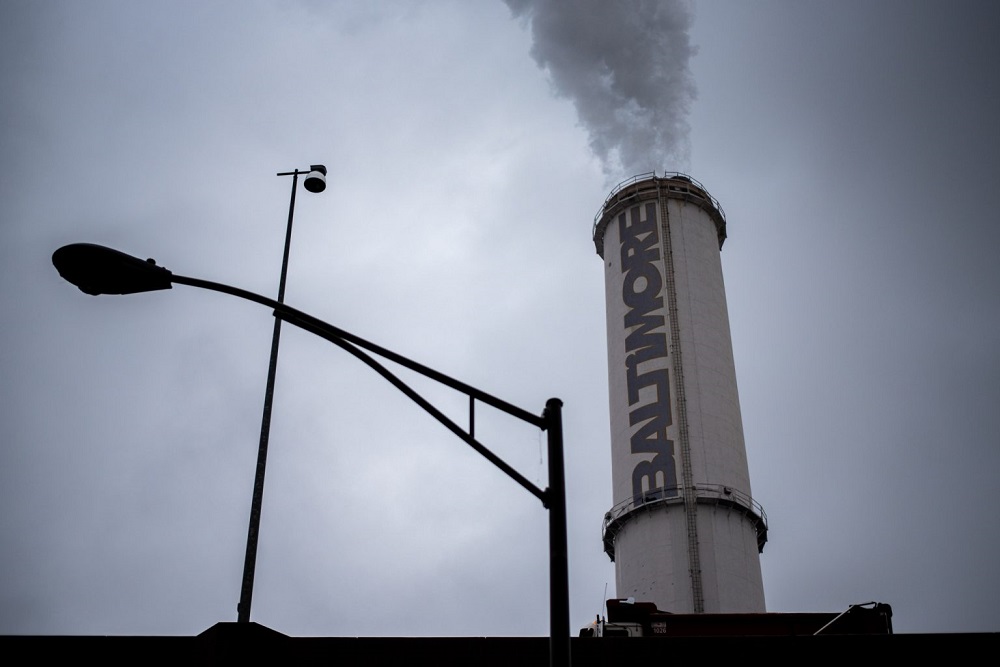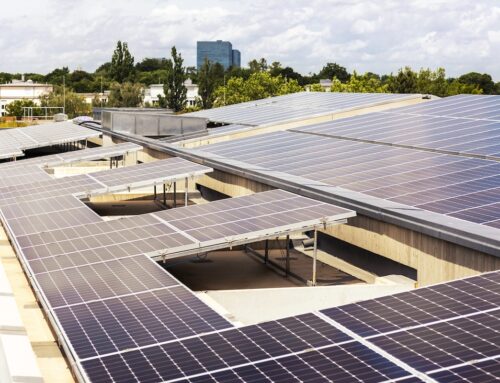Ferguson seeks to remove incinerators from state’s renewable energy subsidy program
October 21, 2024

The years-long effort in Maryland to cut waste-to-energy plants from a state green energy incentive program picked up a powerful ally last week.
In a statement posted to social media, Senate President Bill Ferguson (D-Baltimore City) said he plans to introduce legislation in the upcoming General Assembly session that would remove waste incineration from Maryland’s renewable portfolio standard, which determines what energy sources the state can count to meet certain clean energy mandates.
Similar bills have been introduced almost annually since 2019, most recently in this year’s session, and all have stalled. But with Ferguson’s imprimatur, the legislation could receive the push it needs to finally get through.
Ferguson’s South Baltimore district includes one of the two waste-burning energy plants in the state — the BRESCO plant owned by Wheelabrator Technologies Inc., in the Westport neighborhood of the city. The other is a plant in Dickerson in northern Montgomery County operated by Reworld Waste LLC — and owned by the county government.
Both facilities have been the object of community opposition and concern due to the emissions from the plants — a fact Ferguson acknowledged in his announcement that he plans to sponsor the legislation in 2025.
“Since being elected senator for the 46th Legislative District, I’ve become increasingly concerned about emissions from the BRESCO incinerator as a public health and environmental justice issue for surrounding neighborhoods,” Ferguson said in a statement. “As we take steps to incentivize true, clean energy in Maryland, 2025 must be the year that we remove waste incineration from our Renewable Portfolio Standard (RPS).”
Bills in previous years have sought to remove waste-to-energy and refuse-derived fuel from inclusion in the RPS, by changing what’s known as the energy source’s “Tier 1 status.” That designation made the two incinerators eligible for financial incentives for renewable energy, known as RECs, which also go to other green sources like wind and solar energy.
RECs are used to ensure that energy flowing into the electric grid comes from renewable power sources, with each REC representing the environmental benefits of a single megawatt hour of renewable energy. Energy customers who want to use renewable energy can buy a renewable energy certificate to match each megawatt hour of energy they consume — a way of separating the renewable energy they want to buy from energy generated by fossil fuels.
With air pollution emanating from waste-to-energy facilities, critics of keeping these plants in the state RPS have thought the idea of removing them from the RPS would be a no-brainer; but the complexities of the state’s renewable energy guidelines, coupled with intensive lobbying campaigns, have short-circuited the legislation in the past.
Ferguson has supported similar bills in the past, but never as prime sponsor. He did vote against amending the measure on to a separate piece of legislation during a 2021 floor vote.
Earlier this year, Ferguson became general counsel of CI Renewables, a Baltimore solar energy company. In that role, he is mostly handling transactional work rather than policy or advocacy, but the position could occasionally complicate his legislative activity on clean energy issues.
Ferguson was not immediately available to comment Monday evening; the Senate under his leadership passed the sweeping Climate Solutions Now Act of 2022 and several clean energy measures before he started his new job.
Wheelabrator is already gearing up for the fight in 2025.
“Similar legislation has been introduced over the past several years, but each proposal undermined the Renewable Portfolio Standard program’s goal to reduce our reliance on fossil fuels,” the company said in a statement provided to Maryland Matters Monday from its State House lobbyist, Lisa Harris Jones. “Maryland has minimal wind and solar and relies predominantly on energy from nuclear, natural gas and coal. Waste to energy (WTE), like nuclear, utilizes resources that are plentiful, creating a renewable baseload energy source as demand for reliable energy increases.
“Decades of peer-reviewed and accredited data from Europe and the United States prove WTE facilities are safe for residents and [Wheelabrator] has recently invested nearly $50 million to make our Baltimore facility among the cleanest in the world. Eighty-one percent of Maryland’s portfolio comes from out-of-state sources and this bill increases that reliance. Excluding WTE from the RPS requires Marylanders to subsidize out-of-state businesses while ignoring the work [Wheelabrator] does to divert waste from landfills and reduce greenhouse gases while avoiding fossil fuels.”
A study by the Maryland Public Service Commission, which regulates utilities, found that power from the waste-to-energy plants accounted for 6.9% of Tier 1 RECs used for meeting the state’s renewable energy guidelines in 2022.
Analyzing the most recent bill seeking to eliminate the trash incinerators from the RPS, the Department of Legislative Services predicted that the state will “most likely” continue the long-term trend of growing reliance on wind and solar RECs to meet RPS requirements, with negligible impacts on REC prices or customer electricity rates.
Market problems, poor planning cause price hikes in nation’s largest electric market, critics say
But that analysis was made before more recent reports that utility rates are skyrocketing as energy supply and transmission challenges pound the electric grid. The waste plant operators are certain to argue that taking away their subsidy could lead to higher energy costs for consumers — and that their elimination could jeopardize the financial stability of the industry. Without waste-to-energy plants, they are likely to argue, more trash will need to be trucked to out-of-state landfills, creating more greenhouse gas emissions.
“Any proposal to remove waste-to-energy (WTE) from the Maryland’s Renewable Portfolio Standard fundamentally misses the point of the program,” Marilyn Lynch, executive director of the Waste-to-Energy Association, told Maryland Matters in an email Monday. “The State should continue to support technologies that reduce greenhouse gases emissions, create jobs, and generate clean renewable energy. WTE facilities do just that.
“WTE facilities avoid methane emissions from landfills, generate nine times more energy than any landfill gas project can capture and recycle metal that would be lost forever in a landfill. WTE is highly regulated and must meet the highest environmental standards to protect human health and the environment. In fact, the Waste-To-Energy Association (WTEA) recently conducted a residual risk analysis by a third-party EPA contractor. That report found no residual health risk from WTE facilities in the U.S.”
‘A ripoff for Marylanders’
Environmentalists who have fought the inclusion of waste-to-energy production in the state RPS were heartened by Ferguson’s commitment to the legislation. The group Clean Water Action said in a statement that passing the measure would right a historical “injustice.”
“We are excited that Senate President Ferguson will sponsor the Reclaim Renewable Energy Act, which will eliminate trash incineration from Maryland’s Renewable Portfolio Standard and end subsidies for burning trash as renewable energy,” the group said. “For over a decade, Maryland has wasted over $100 million cumulatively subsidizing trash incineration as ‘renewable energy,’ despite the fact that incinerators emit more greenhouse gas emissions per unit of energy produced than any other power source, even coal.”
Del. Vaughn Stewart (D-Montgomery), who sponsored this year’s legislation along with Sen. Karen Lewis Young (D-Frederick), said he was “overjoyed” that Ferguson has decided to sponsor the measure.
“Any Annapolis observer would have to recognize that when the presiding officer of a chamber signs on to a piece of legislation, that bolsters its prospects,” he said.
The renewed battle over the RPS comes as Maryland lawmakers look to do more to promote home-grown clean energy, and the House appears poised to make tweaks to the RPS. Several lawmakers are talking about trying to add nuclear power — far and away the most widely-utilized carbon-free energy in the state — to the RPS.
YOU MAKE OUR WORK POSSIBLE.
Del. Lorig Charkoudian (D-Montgomery), who has co-sponsored prior bills to eliminate waste-to-energy from the RPS, is developing legislation to overhaul the RPS program altogether. And House Economic Matters Committee Chair C.T. Wilson (D-Charles) is expected to reintroduce legislation he proposed late in this year’s session that would prevent local governments from blocking proposed clean energy projects in their jurisdictions.
Stewart was optimistic the waste incinerator bill would pass next year.
“The winning argument is that it’s a boondoggle,” he said. “It’s a rip-off for Marylanders to subsidize highly profitable corporations. Because the only thing they’re getting from this subsidy is polluted air.”
The legislature regularly makes tweaks to the RPS. Most recently, in 2021, lawmakers voted to remove “black liquor,” the byproduct from paper production, from receiving the renewable energy subsidy. That subsidy largely became moot after the state’s lone paper plant, in Allegany County, shuttered in 2019.
“I look forward to ensuring we only incentivize true green energy moving forward,” Ferguson said.
Search
RECENT PRESS RELEASES
Related Post


